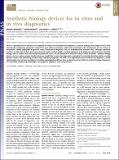| dc.contributor.author | Slomovic, Shimyn | |
| dc.contributor.author | Pardee, Keith | |
| dc.contributor.author | Collins, James J. | |
| dc.date.accessioned | 2017-05-04T22:52:56Z | |
| dc.date.available | 2017-05-04T22:52:56Z | |
| dc.date.issued | 2015-11 | |
| dc.date.submitted | 2015-05 | |
| dc.identifier.issn | 0027-8424 | |
| dc.identifier.issn | 1091-6490 | |
| dc.identifier.uri | http://hdl.handle.net/1721.1/108679 | |
| dc.description.abstract | There is a growing need to enhance our capabilities in medical and environmental diagnostics. Synthetic biologists have begun to focus their biomolecular engineering approaches toward this goal, offering promising results that could lead to the development of new classes of inexpensive, rapidly deployable diagnostics. Many conventional diagnostics rely on antibody-based platforms that, although exquisitely sensitive, are slow and costly to generate and cannot readily confront rapidly emerging pathogens or be applied to orphan diseases. Synthetic biology, with its rational and short design-to-production cycles, has the potential to overcome many of these limitations. Synthetic biology devices, such as engineered gene circuits, bring new capabilities to molecular diagnostics, expanding the molecular detection palette, creating dynamic sensors, and untethering reactions from laboratory equipment. The field is also beginning to move toward in vivo diagnostics, which could provide near real-time surveillance of multiple pathological conditions. Here, we describe current efforts in synthetic biology, focusing on the translation of promising technologies into pragmatic diagnostic tools and platforms. | en_US |
| dc.description.sponsorship | United States. Defense Threat Reduction Agency (Grant HDTRA1-14-1- 0006) | en_US |
| dc.description.sponsorship | United States. Office of Naval Research. Multidisciplinary University Research Initiative | en_US |
| dc.description.sponsorship | United States. Air Force Office of Scientific Research (Grant FA9550-14-1-0060) | en_US |
| dc.description.sponsorship | Wyss Institute for Biologically Inspired Engineering | en_US |
| dc.description.sponsorship | Howard Hughes Medical Institute | en_US |
| dc.language.iso | en_US | |
| dc.publisher | National Academy of Sciences (U.S.) | en_US |
| dc.relation.isversionof | http://dx.doi.org/10.1073/pnas.1508521112 | en_US |
| dc.rights | Article is made available in accordance with the publisher's policy and may be subject to US copyright law. Please refer to the publisher's site for terms of use. | en_US |
| dc.source | National Academy of Sciences (U.S.) | en_US |
| dc.title | Synthetic biology devices for in vitro and in vivo diagnostics | en_US |
| dc.type | Article | en_US |
| dc.identifier.citation | Slomovic, Shimyn, Keith Pardee, and James J. Collins. “Synthetic Biology Devices for in Vitro and in Vivo Diagnostics.” Proceedings of the National Academy of Sciences 112.47 (2015): 14429–14435. © 2015 National Academy of Sciences | en_US |
| dc.contributor.department | Massachusetts Institute of Technology. Institute for Medical Engineering & Science | en_US |
| dc.contributor.department | Massachusetts Institute of Technology. Synthetic Biology Center | en_US |
| dc.contributor.department | Massachusetts Institute of Technology. Department of Biological Engineering | en_US |
| dc.contributor.mitauthor | Slomovic, Shimyn | |
| dc.contributor.mitauthor | Collins, James J. | |
| dc.relation.journal | Proceedings of the National Academy of Sciences of the United States of America | en_US |
| dc.eprint.version | Final published version | en_US |
| dc.type.uri | http://purl.org/eprint/type/JournalArticle | en_US |
| eprint.status | http://purl.org/eprint/status/PeerReviewed | en_US |
| dspace.orderedauthors | Slomovic, Shimyn; Pardee, Keith; Collins, James J. | en_US |
| dspace.embargo.terms | N | en_US |
| dc.identifier.orcid | https://orcid.org/0000-0003-4873-3222 | |
| dc.identifier.orcid | https://orcid.org/0000-0002-5560-8246 | |
| mit.license | PUBLISHER_POLICY | en_US |
| mit.metadata.status | Complete | |
